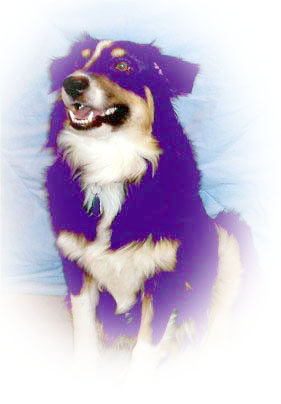
"An Aussie of a Different Color"

Yes, that picture is supposed to be a purple blue (if your monitor is set right).
There are four accepted colors of Australian Shepherds: Blue Merle, Black, Red Merle, and Red. When breeding, there are other colors that may crop up, but they are not accepted colors and shouldn't be bred for (I've heard breeders bragging about getting some of these colors in their litters - meaning they are not too concerned with the set standard that they should be breeding for). The other common (unaccepted) colors are Yellow, Sable, and Dilute.
I have a few pet peeves and breeders who don't know their colors is one of them. I have seen breeders advertise a "light red" that is actually a yellow. I've seen a "chocolate" advertised, and this was actually a dilute (not to mention there is no "chocolate" Aussie). If you are looking to buy an Aussie and they have a red listed as a "chocolate" or "brown", please don't buy from that person because they have no clue as to what they are doing.
I'll also discuss markings in this article a little further down. Now, onto the colors:
Blue Merle

This is the color the Australian Shepherd is known for. I hate it when someone refers to a blue merle as "black and white" (if your dog is white with black spots, its not a merle). A blue merle can be almost any shade of gray or blue with black spots and patches. They can range from a powder blue to a deep blue. The eye rims and nose on a blue merle will always be black (although they can have pink flecks). They do not have to have white or copper trim, and you can have a blue merle with only one or the other (although not very common in show lines). The eyes can be brown, amber, blue, or green and can be marbled with any combination two of those colors (marbling is rather common in merles).
Black

This is my favorite color! I'm a real sucker for a black tri. However, the dog pictured above is a black bi (no copper). Blacks are to be a solid black color. They can bleach out if they stay outside all the time and get brownish/reddish patches. Its not very attractive though. The eye rims and nose on a black should also be black. Again, they can have copper and white, but its not a given. You can have a solid black (no copper or white), a black bi (black and white or black and copper), or a black tri (black, white, and copper). The eye color can be brown, amber, blue, or green. It is not as common to get blue, amber, or green eyes on a black, but you can have it. The eyes on a black can not be marbled (flecks of other color in it). It can, however, be split down the middle with two different colors. If your black has marbled eyes, you have a phantom merle on your hands. It is possible to get a blue merle that looks exactly like a black with only a small patch of merle located somewhere on the body (can be located on the tail, which is docked at birth). If a phantom merle is bred to a black or red, you will get merle puppies (as with a true black or red, you would get only solid puppies). If you breed a phantom merle to another merle, you will get solids, merles, and lethal whites (homozygous merles).
Red Merle

The red merle is a very similar to the blue merle, except that it is cream or gray with red spots. The red spots can very from a light chocolaty color to a deep liver. The background can be a cream or a silver gray. Usually when you see a red merle that has a gray background with deep liver spots it is referred to as a "mahogany" red merle. These can often be mistaken for a blue merle. The eye rims and nose on a red merle should be liver in color (they can have pink flecks). Like the blue and black, they can have either white or copper trim or none. The eyes can be brown, amber, green, or blue, and can be marbled any two of those colors. Usually, you don't see brown eyes on a red merle, its more common to have amber.
Red
If you have a picture to put here, please e-mail me.
Last, but not least, is the red Australian Shepherd. The red can range from a light chocolaty color to a deep liver. If left outside all the time, a red can bleach out to almost a yellow color. The eye rims and nose should be liver in color. They can come with or without white and copper trim. They can have brown, amber, green, or blue eyes. Amber being more common than brown in reds.
I'll now discuss markings, if I don't have a picture of something mentioned here, and you have one, please let me know.
White Markings

The white markings on an Australian Shepherd are accepted on the muzzle and face (but not going over the eye or ear area), the back of the head, the neck (forming a full white collar), the chest, the belly, the front and back legs. Aussies can have white on the ear, eyes and past the withers, but these areas are considered faulted (see "white body splashes"). Notice that the above black bi girl has white on her ear.
Copper Markings
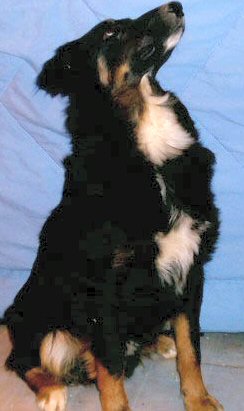
Copper markings are usually found on the legs, stifles, cheeks, throat, above the eyes (eyebrows), and around the butt. Copper can range from a dull copper to a bright tan color. You can have a dog that has copper with no white. Copper doesn't exceed its usual areas. Of course, the dog doesn't have to have copper at all, let alone all the areas listed above. White markings are dominant over copper markings.
Smudgy Copper Markings
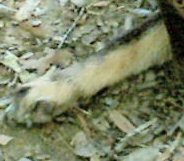
The above picture is an Aussie's leg. I hope you can tell what it is. The picture is rather dark, but the dog portrayed is a deep liver red. The dog has no white on the legs, only copper. Notice how the red runs into the copper areas? This is what is called "smudgy" copper. You will note the red is very obvious on the toes, but you can see traces of it along the top and bottom of the leg. This is a rather undesirable trait.
Ticking
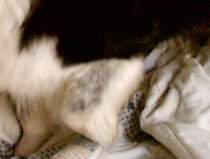
This is a picture of another Aussie's leg. The dog portrayed is a black. You'll notice the smudgy black marking on the leg that almost looks like a merle pattern. This is actually ticking. Ticking is black/red or copper spots on the white. Some people like ticking and some don't. I don't know if its faulted in a show ring or not.
White Body Splashes
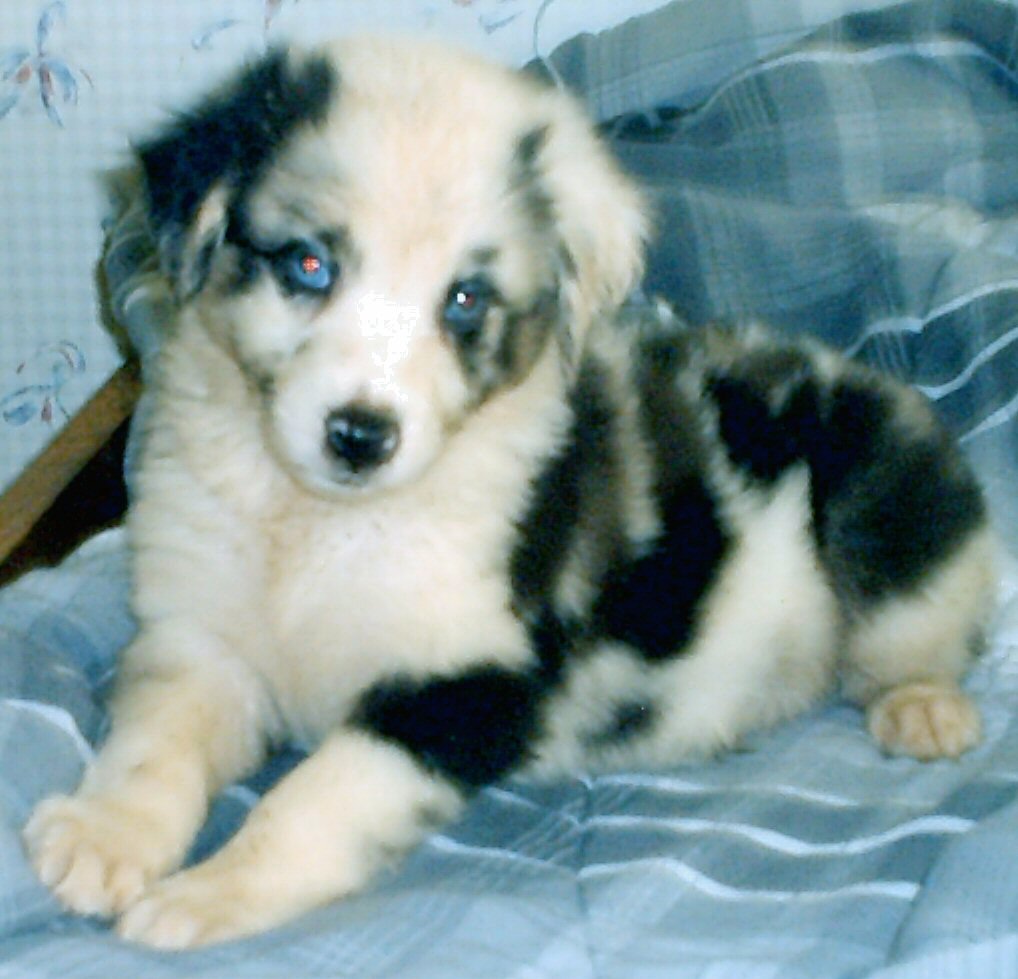
White body splashes include any white markings between the withers and tail, and on the sides from elbows to the back of hindquarters. In the picture above, the puppy has white coming up his side to the top of his hind leg. This particular pup also has white extending past the withers on the opposite side and small white patches throughout his coat. He also has one white ear. This pup is not a lethal white/homozygous merle!
Okay, that concludes my information on colors and markings!